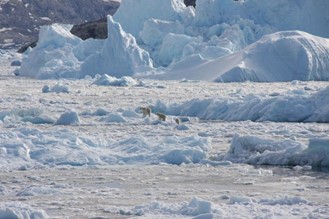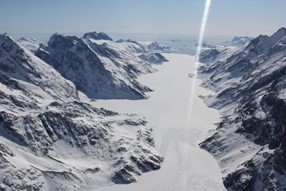Polar bears in Southeast Greenland belong to a population separated from the rest of East Greenland
This finding has just been presented in the highly esteemed journal Science. Professor Rune Dietz and Professor Christian Sonne, Arctic Research Center, Aarhus University, Denmark participated in the research.


Data from genetics, movements and observations show that this previously-undocumented population survives with limited access to sea ice — by hunting from freshwater ice that pours into the ocean from Greenland’s glaciers.
In East Greenland polar bears are distributed over the largest habitat of all the world´s polar bear populations. Previously polar bears in East Greenland were regarded as belonging to one population, ranging throughout the whole coast of East Greenland.
As part of an assessment to advise the Government of Greenland about management and conservation of polar bears, the Greenland Institute of Natural Resources (GINR) undertook the task to determine whether polar bears in East Greenland is subdivided into more than one population.
Prior to this study the southeastern parts of the East Greenland coast south of Tasiilaq, in particular, had been poorly studied because of its remoteness and challenging environmental conditions, including highly unpredictable weather, jagged mountains, fjords with little sea ice, and heavy snowfall.
During 2015-2022, GINR scientists and colleagues interviewed local hunters and surveyed all portions of the coast of East Greenland coast by tagging and biopsying polar bears, collecting information on biology, movements and genetics of bears from Prins Christiansund in the south as far Kap Morris Jessup in the north. This information was combined with data collected over 35 years during various studies of polar bears on East Greenland, and with hunter’s samples from the East Greenland subsistence harvest.
The study documented that polar bears in East Greenland belong to two populations and that the newly described population occurs in Southeast Greenland between 60-64 degrees N. Southeast Greenland polar bears are the most genetically distinct polar bears in the world. In fact, the genetic analyses show that this group of bears is more different from its nearest genetic neighbor than any of the 19 previously known polar bear populations.
Satellite tracking of adult females between 2015-2022 shows that, unlike most other polar bears that travel far over sea ice to hunt, Southeast Greenland bears stay close to their homes. They walk on ice inside protected fjords or up mountains to reach neighboring fjords. Half of the bears that were tracked, accidentally drifted more than 200 kilometers south on sea ice floes when caught in the rapid East Greenland current, but then hopped off and walked back north to their home fjord on land on the inland ice cap.
The Government of Greenland will decide on any management measures of the new findings. Currently there is a subsistence hunt regulated by quotas to be taken by licensed local hunters. The quota of 2022 was of 69 polar bears in East Greenland, allocated to three regions: Ittoqqortoormiit in central East Greenland, Tasiilaq in SE Greenland, and Southwest Greenland, where polar bears are transported by sea ice drifting from East Greenland.
Facts box
The study began in 2014 with a Traditional Ecological Knowledge interview survey of polar bear hunters in all towns and settlements of East Greenland to gather information about hunter’s observations and opinions, as well advice on where to look for bears. Hunters contributed experience, participation, and genetic samples from their subsistence harvest throughout the study.
In total in Southeast Greenland 126 polar bears were captured and released, 32 were remote biopsied, and 146 unmarked bears sighted during three spring seasons (2015-2017). A total of 27 adult female polar bears were furnished with satellite transmitters south of Tasiilaq as far south as Prince Christiansund. These data were combined with 388 other tissue samples in East Greenland from the subsistence harvest, bears killed in defense of life or property, live captured and released for research purposes, or remotely biopsied from a helicopter.
The study was led by Pinngortitalerrifik/ the Greenland Institute of Natural Resources and conducted in collaboration with the University of Washington, University of Santa Cruz California, Aarhus University, Norwegian Polar Institute, the University of Oslo, the US National Snow and Ice Data Center and Wildlife Genetics International.
Funds were provided by Environmental Protection Agency (Ministry of Environment and Food of Denmark), DANCEA Program, Danish Ministry of the Environment under Miljøstøtte til Arktis (the Northeast Greenland Environmental Study Program), The Government of Greenland through the Strategic Environmental Plan for Northeast Greenland, Greenland Institute of Natural Resources, Leo Model Foundation, Vetlesen Foundation, National Aeronautics and Space Administration, and US National Science Foundation.
More information
- Contacts: Kristin Laidre (klaidre@uw.edu) and Fernando Ugarte (feug@natur.gl), pone: +299 522401
- Manuscript accessible at https://doi.org/10.1126/science.abk2793
- Traditional Knowledge interview survey: https://www.frontiersin.org/articles/10.3389/fmars.2018.00135/full
